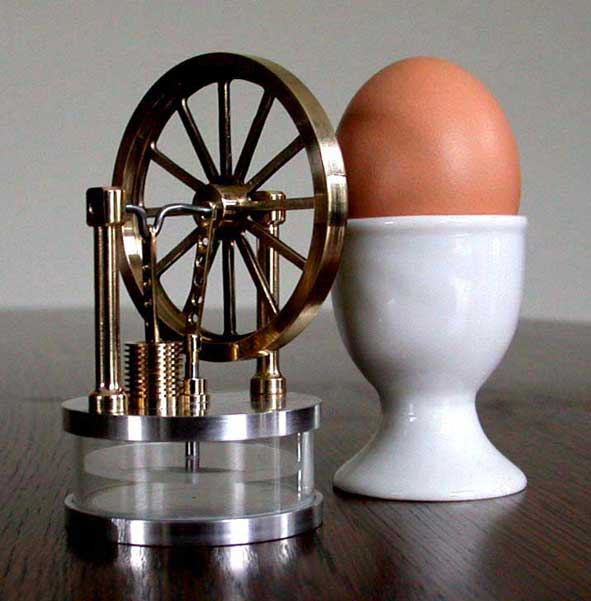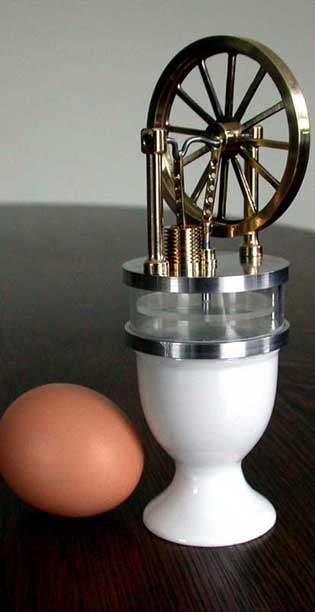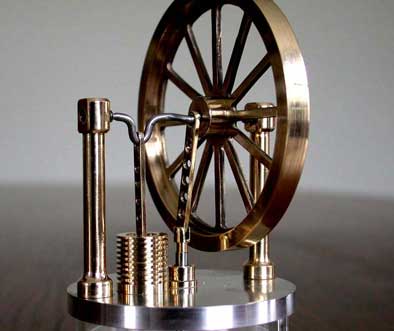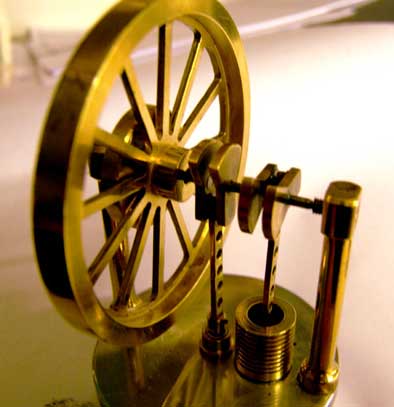Egg Cup Stirling
The Idea
Apparently I cannot suppress my propensity to minimize and simplifying things. After my first five coffee cup Stirlings I wanted to make a model that should run on a egg-cup filled with hot water. Forced by the small dimensions I had to implement some construction changes.

The work-out
Except for the proportional smaller dimensions for the cylinder with the displacer and the cold cylinder with the working piston this model above all differs with respect to the crank shaft and the bearing of it. This crank shaft is a one piece steel wire with diameter 1.8mm. I made a special bending jig to make the curved eccentrics with right dimensions and under the angle of 90°.
Later I changed this crank shaft as you can see on the video and on the extra picture on the right bottom of this page. May be even less difficult to make and in fact somewhat better to keep the driving rods in place. The present drawing plan is based on this new version of the crank shaft.
I made point bearings as you mostly encounter in clockworks. For that both ends of the crank shaft are grinded conical with a top angle of 60°. The crank shaft is fixed between two 3mm thread ends (screwed in the pillar stands) which have conical cavities with top angle 90°. The right adjustment for the bearing clearance and for the horizontal position of the crank shaft is simple a matter of screwing this thread ends somewhat in and out.
I made a glass displacer cylinder, but you can use transparant plastic as well (acrylic PMMA). In the aluminium plates there are grooves in what the cylinder is cemented air-tight with silicone kit so you don't need the six screws on the circumference. This decreases the heat transfer from the bottom plate to the upper plate. Dismantling is somewhat more difficult then, but in fact that is not necessary anymore if cementing is done as last assembly treatment.
I made the displacer from 2mm thick plexiglass. The advantage is that the displacer axis can be screwed directly in the displacer so you can skip the aluminium mandrel that you need with soft polystyrene.
All together this became a very simple little engine with only 16 parts, all easy to make. May be this is also the reason why it fascinates so much seeing this engine run on an egg cup with hot water.
Performance.
Placed on an egg cup with boiled water this little thing is running smoothly and noiseless during 5 to 10 minutes with a speed of about 200 rpm max. This speed is attained after 2 minutes and decreases gradually due to the cooling down of the water in the cup. Of course this relative short run-time is caused by the low heat capacity of the small amount of water in the egg-cup. It is possible to run this engine for a longer time or even continuously placing it on a substrate that keeps warm, i.e. on a household teapot warmer. But don't exceed 100 °C to avoid damage to the plastic parts.Video:
Drawing plan
I made a CAD drawing plan for this Egg Cup Stirling that is available for every one interested; click here for a request.




New crank shaft